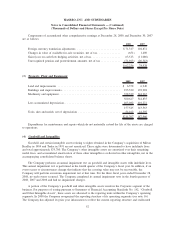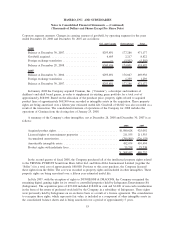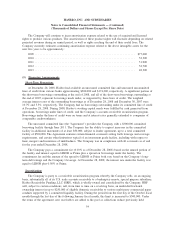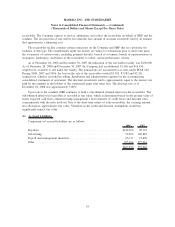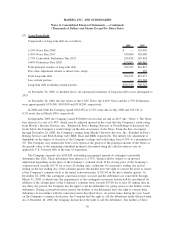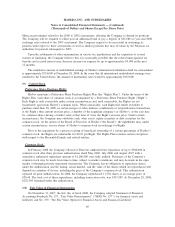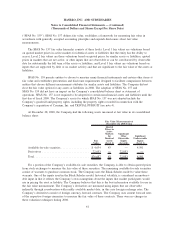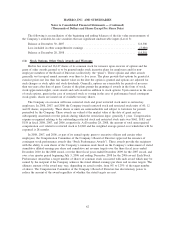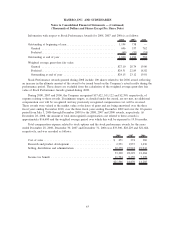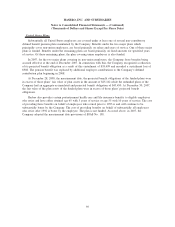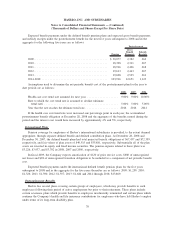Hasbro 2008 Annual Report Download - page 71
Download and view the complete annual report
Please find page 71 of the 2008 Hasbro annual report below. You can navigate through the pages in the report by either clicking on the pages listed below, or by using the keyword search tool below to find specific information within the annual report.
(“SFAS No. 159”). SFAS No. 157 defines fair value, establishes a framework for measuring fair value in
accordance with generally accepted accounting principles and expands disclosures about fair value
measurements.
The SFAS No. 157 fair value hierarchy consists of three levels: Level 1 fair values are valuations based
on quoted market prices in active markets for identical assets or liabilities that the entity has the ability to
access; Level 2 fair values are those valuations based on quoted prices for similar assets or liabilities, quoted
prices in markets that are not active, or other inputs that are observable or can be corroborated by observable
data for substantially the full term of the assets or liabilities; and Level 3 fair values are valuations based on
inputs that are supported by little or no market activity and that are significant to the fair value of the assets or
liabilities.
SFAS No. 159 permits entities to choose to measure many financial instruments and certain other items at
fair value and establishes presentation and disclosure requirements designed to facilitate comparisons between
entities that choose different measurement attributes for similar assets and liabilities. The Company did not
elect the fair value option for any assets or liabilities in 2008. The adoption of SFAS No. 157 and
SFAS No. 159 did not have an impact on the Company’s consolidated balance sheet or statement of
operations. SFAS No. 157 is not required to be adopted for certain non-financial assets and liabilities until the
first day of fiscal 2009. The Company’s assets for which SFAS No. 157 was not adopted include the
Company’s goodwill and property rights, including the property rights recorded in connection with the
Company’s acquisition of Cranium, Inc. and TRIVIAL PURSUIT (see note 4).
At December 28, 2008, the Company had the following assets measured at fair value in its consolidated
balance sheet:
Fair
Value
Quoted
Prices in
Active
Markets
for
Identical
Assets
(Level 1)
Significant
Other
Observable
Inputs
(Level 2)
Significant
Unobservable
Inputs
(Level 3)
Fair Value Measurements at
December 28, 2008 Using
Available-for-sale securities .................. $ 4,634 43 — 4,591
Derivatives .............................. 72,053 — 72,053 —
Total ................................... $76,687 43 72,053 4,591
For a portion of the Company’s available-for-sale securities, the Company is able to obtain quoted prices
from stock exchanges to measure the fair value of these securities. The remaining available-for-sale securities
consist of warrants to purchase common stock. The Company uses the Black-Scholes model to value these
warrants. One of the inputs used in the Black-Scholes model, historical volatility, is considered an unobserv-
able input in that it reflects the Company’s own assumptions about the inputs that market participants would
use in pricing the asset or liability. The Company believes that this is the best information available for use in
the fair value measurement. The Company’s derivatives are measured using inputs that are observable
indirectly through corroboration with readily available market data, in this case foreign exchange rates. The
Company’s derivatives consist of foreign currency forward contracts. The Company uses current forward rates
of the respective foreign currencies to measure the fair value of these contracts. There were no changes in
these valuation techniques during 2008.
61
HASBRO, INC. AND SUBSIDIARIES
Notes to Consolidated Financial Statements — (Continued)
(Thousands of Dollars and Shares Except Per Share Data)



